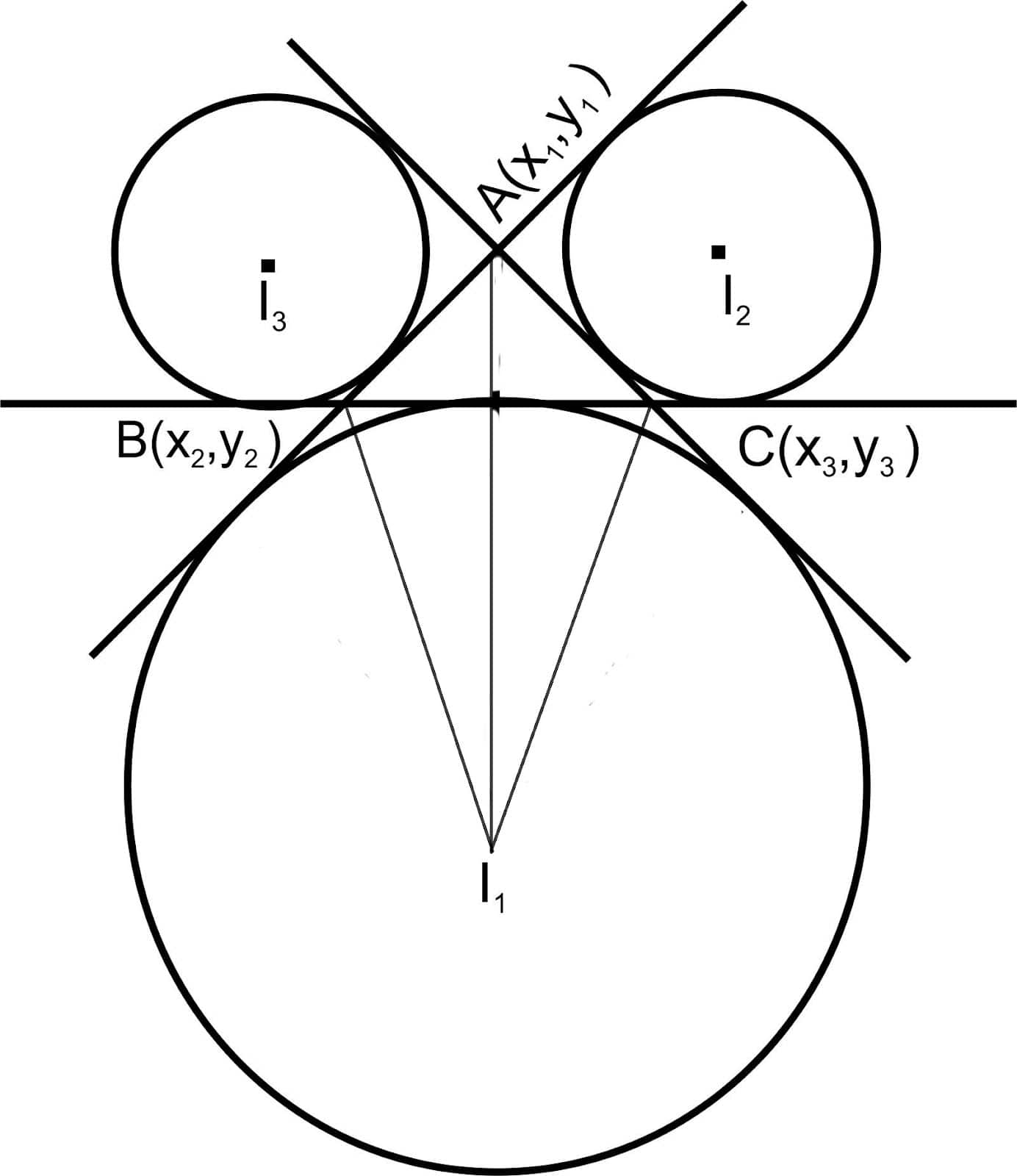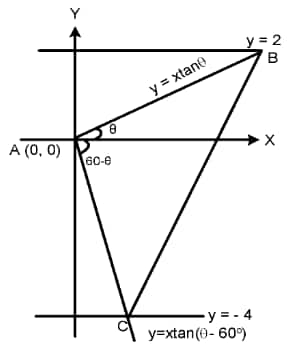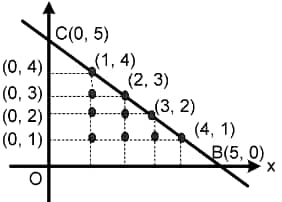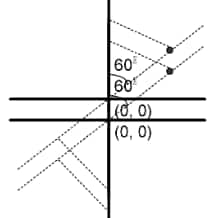Excenter of a triangle
The excenter of a triangle is a special point where the internal bisector of one angle and the external bisectors of the other two angles meet. Every triangle has three excenters, each corresponding to one of its vertices, and each excenter serves as the centre of an excircle that touches one side of the triangle and the extensions of the other two. For example, the A-excenter is associated with vertex $A$ and its excircle touches sides $AB$, $AC$, and $BC$ at specific tangency points whose locations can be determined using the excenter of a triangle formula in mathematics. The study of excenters involves understanding their properties, deriving the coordinates of an excenter from the triangle’s vertices, finding the distance between the incenter and excenter, and exploring the geometry of the points of tangency. In this article, we will cover these definitions, formulas, coordinate derivations, and important properties in detail.
What is the Excenter of a Triangle?
The excenter of a triangle is a special point in geometry that acts as the centre of a circle, called the excircle, which touches one side of the triangle externally and the extensions of the other two sides. Every triangle has three excenters, each corresponding to one vertex.
In coordinate geometry, the excenter of a triangle formula is used to calculate the location of this point using the vertices and side lengths. The excenter is also linked to important properties of excenter and points of tangency that are widely used in both pure and applied mathematics.
Definition of Excenter in Geometry
In geometry, an excenter is defined as the intersection point of two external angle bisectors and one internal angle bisector of a triangle.
For a triangle $ABC$, the excenter opposite vertex $A$ is denoted as $I_A$ (also called the A-excenter). The A-excircle associated with $I_A$ touches:
side $BC$ at tangency point $D$
the extension of side $AB$ at $E$
the extension of side $AC$ at $F$
If $a$, $b$, and $c$ are the lengths of sides $BC$, $CA$, and $AB$ respectively, and $(x_A, y_A)$, $(x_B, y_B)$, $(x_C, y_C)$ are their coordinates, the formula for coordinates of the excenter opposite $A$ is:
$I_A = \left( \frac{-a \cdot x_A + b \cdot x_B + c \cdot x_C}{-a + b + c}, \frac{-a \cdot y_A + b \cdot y_B + c \cdot y_C}{-a + b + c} \right)$
Understanding the Concept of Excentre and Excircle
The excentre always lies outside the triangle and serves as the center of the excircle.
The radius of the excircle opposite $A$ is:
$r_A = \frac{\Delta}{s-a}$
where:
$\Delta$ is the area of the triangle
$s = \frac{a+b+c}{2}$ is the semi-perimeter
$a$ is the length of side $BC$
The points of tangency between the excircle and the sides can be calculated using the formula for the coordinates of the excenter and the points of tangency in a triangle, which is particularly useful in coordinate geometry.
Difference Between Incenter and Excenter
While the incenter is the intersection of the three internal angle bisectors and is the centre of the incircle (which touches all sides internally), the excenter involves two external and one internal angle bisector.
Key differences:
Property | Incenter | Excenter (A-excenter) |
Position | Inside the triangle | Outside the triangle |
Circle type | Incircle | Excircle |
Coordinate formula | All side weights positive | One side weight negative |
Distance to incenter | $d = \sqrt{(x_I - x)^2 + (y_I - y)^2}$ | Distance between incenter and excenter formula involves $r$ and $r_A$ |
This distinction helps in applying the properties of excenter and points of tangency in a triangle to both theoretical and coordinate-based problems.
Excentre of Triangle Formula
An excenter is a point where the bisector of one interior angle of a triangle meets the bisectors of the two exterior angles at the other two vertices.
Let $A(x_1, y_1)$, $B(x_2, y_2)$, and $C(x_3, y_3)$ be the vertices of $\triangle ABC$, such that:
$BC = a$
$CA = b$
$AB = c$
The circle that touches the side $BC$, and the extensions of $AB$ and $AC$, is called the escribed circle opposite the angle $A$.
The bisectors of the external angles at $B$ and $C$ meet at a point $I_1$, which is the center of the escribed circle opposite $A$. If $I_1$ is the intersection of the internal bisector of $\angle BAC$ and the external bisectors of $\angle ABC$ and $\angle ACB$, then the coordinates of the three excenters are:
A-excenter $I_1$:
$I_1 = \left( \frac{-a x_1 + b x_2 + c x_3}{-a + b + c}, \frac{-a y_1 + b y_2 + c y_3}{-a + b + c} \right)$
B-excenter $I_2$:
$I_2 = \left( \frac{a x_1 - b x_2 + c x_3}{a - b + c}, \frac{a y_1 - b y_2 + c y_3}{a - b + c} \right)$
C-excenter $I_3$:
$I_3 = \left( \frac{a x_1 + b x_2 - c x_3}{a + b - c}, \frac{a y_1 + b y_2 - c y_3}{a + b - c} \right)$

Properties of the Excenter of a Triangle
The properties of the excenter (or excentre) of a triangle are fundamental in both pure geometry and coordinate geometry. These properties explain the location of each excenter, its relationship with the points of tangency, and various geometrical and algebraic characteristics. The formula for the coordinates of the excenter and points of tangency in a triangle allows precise calculation in analytical geometry.
Location of Each Excenter in a Triangle
A triangle $ABC$ has three excenters, each corresponding to one vertex:
A-excenter $I_A$ : opposite vertex $A$
B-excenter $I_B$ : opposite vertex $B$
C-excenter $I_C$ : opposite vertex $C$
If $(x_A, y_A)$, $(x_B, y_B)$, and $(x_C, y_C)$ are the vertices, and $a$, $b$, and $c$ are the lengths of $BC$, $CA$, and $AB$ respectively, then:
$I_A = \left( \frac{-a \cdot x_A + b \cdot x_B + c \cdot x_C}{-a + b + c}, \frac{-a \cdot y_A + b \cdot y_B + c \cdot y_C}{-a + b + c} \right)$
Similarly, $I_B$ and $I_C$ are found by cyclic permutations of $a$, $b$, and $c$.
Relationship Between Excenter and Points of Tangency
The A-excircle touches:
Side $BC$ at point $D$
Extension of $CA$ at point $E$
Extension of $AB$ at point $F$
If $s$ is the semi-perimeter of $\triangle ABC$, then:
$BD = s - b \quad \text{and} \quad DC = s - c$
These tangency points can be computed using the formula for the coordinates of excenter and the points of tangency in a triangle, allowing accurate placement in coordinate geometry.
Key Geometrical Properties of Excenters
Properties of Excentre:
External position: Excenters always lie outside the triangle.
Equilateral triangle property: The excentres of an equilateral triangle are equidistant from each other, and this distance is twice the side of the triangle.
Tangent circle property: Each excenter is the centre of an excircle tangent to one side of the triangle and the extensions of the other two sides.
Angle bisector property: The excenter is the intersection point of the internal angle bisector of one vertex and the external angle bisectors of the other two vertices.
Collinearity with orthocenter: The three excenters and the orthocenter of the triangle are collinear.
Orthocentric system property: The incenter and the three excenters form an orthocentric system, with the incenter as the orthocenter of the triangle formed by the excenters.
Additional mathematical facts:
Exradius formula: The radius of the excircle opposite $A$ is
$r_A = \frac{\Delta}{s-a}$
where $\Delta$ is the area of the triangle and $s$ is the semi-perimeter.Distance between incenter and excenter:
$II_A = \sqrt{R(R - 2r)}$
where $R$ is the circumradius and $r$ is the inradius.
Solved Examples Based on Excentre of a triangle
Solution: Let in $\triangle ABC$, $A(0,0)$, $B\left(\frac{a}{2}, \frac{\sqrt{3}a}{2}\right)$, and $C(a, 0)$.
Coordinates of $I_1$:
$ I_1 \equiv \left( \frac{-a x_1 + b x_2 + c x_3}{-a + b + c}, \frac{-a y_1 + b y_2 + c y_3}{-a + b + c} \right) $
Coordinates of $I_2$:
$ I_2 \equiv \left( \frac{a x_1 - b x_2 + c x_3}{a - b + c}, \frac{a y_1 - b y_2 + c y_3}{a - b + c} \right) $
Coordinates of $I_3$:
$ I_3 \equiv \left( \frac{a x_1 + b x_2 - c x_3}{a + b - c}, \frac{a y_1 + b y_2 - c y_3}{a + b - c} \right) $
For $I_1$:
$ I_1 = \left( \frac{-a \cdot 0 + a \cdot a + a \cdot \frac{a}{2}}{-a + a + a}, \frac{-a \cdot 0 + a \cdot 0 + a \cdot \frac{\sqrt{3}a}{2}}{-a + a + a} \right) $
$ I_1 = \left( \frac{\frac{3a^2}{2}}{a}, \frac{\frac{\sqrt{3}a^2}{2}}{a} \right) $
$ I_1 = \left( \frac{3a}{2}, \frac{\sqrt{3}a}{2} \right) $
Hence, the minimum distance between two excenters is: $ 2a $.
Solution: From the choice of the axis:
$ A = (0,0) $
$ B = \left( 2 \cot \theta, \ 2 \right) $
$ C = \left( 4 \cot\left(60^\circ - \theta\right), \ -4 \right) $
Now, $(\text{side of equilateral triangle})^2$
$= 4 \cot^2 \theta + 4 = 16 \cot^2(60^\circ - \theta) + 16$
$\Rightarrow 4 \csc^2 \theta = 16 \csc^2(60^\circ - \theta)$
$\Rightarrow \tan \theta = \frac{\sqrt{3}}{5}$
Hence, the required length is $2 \csc \theta = 4 \sqrt{\frac{7}{3}}$
Therefore, the correct answer is $4 \sqrt{\frac{7}{3}}$.
Solution: The adjacent figure indicates that there are exactly $6$ good points inside the quadrilateral $ABCD$.

Hence, the correct answer is $6$.
Solution:
Clearly $a \in \mathbb{R}^+$.
Also $a^2 + a - 2 < 0$.
$\Rightarrow (a + 2)(a - 1) < 0$
$\Rightarrow -2 < a < 1$
$\Rightarrow a \in (0, 1)$
Hence, the correct answer is $a \in (0, 1)$.
Solution:
Clearly, the third vertex will lie on the $y$-axis.
Hence, the points are $(0, 2)$ or $(0, -2)$.
Hence, the correct answer is (0,2).
List of topics related to Excenters of a triangle
The excenters of a triangle are connected to several important topics in coordinate geometry, ranging from the area of a triangle and locus to transformations and rotation of axes, straight lines, equations of straight lines, angles between two lines, and the position of points with respect to a line. Below is the list of these related topics for quick reference.
NCERT Resources
Below are the NCERT resources that provide comprehensive support for learning the topic of Straight Lines in Class 11 Maths. These include detailed notes for Chapter 9, step-by-step solutions for Chapter 10, and exemplar solutions for Chapter 9 to help strengthen your understanding and problem-solving skills.
NCERT Class 11 Maths Notes for Chapter 10 - Straight Lines
NCERT Class 11 Maths Solutions for Chapter 10 - Straight Lines
NCERT Class 11 Maths Exemplar Solutions for Chapter 10 - Straight Lines
Practice Questions based on the Excenters of a Triangle
Below are the practice questions based on the excenters of a triangle and related coordinate geometry concepts. These cover MCQs on topics such as the area of a triangle, locus, transformations and rotation of axes, straight lines, equations of straight lines, angles between two lines, and determining the position of points with respect to a line—helping you test and reinforce your understanding.
Excenters Of a Triangle -Practice Question MCQ
You can also practice the questions below on the topics related to excenters of a triangle:
Frequently Asked Questions (FAQs)
The Coordinates of excentre I1 , I2 and I3 is given by
\begin{aligned} & \mathrm{I}_1 \equiv\left(\frac{-a x_1+b x_2+c x_3}{-a+b+c}, \frac{-a y_1+b y_2+c y_3}{-a+b+c}\right) \\ & I_2 \equiv\left(\frac{a x_1-b x_2+c x_3}{a-b+c}, \frac{a y_1-b y_2+c y_3}{a-b+c}\right) \\ & I_3 \equiv\left(\frac{a x_1+b x_2-c x_3}{a+b-c}, \frac{a y_1+b y_2-c y_3}{a+b-c}\right)\end{aligned}
The excentres of an equilateral triangle are equidistant from each other and this distance is twice the side of the triangle. So, if a is the side length of equilateral traingle then Excentre = 2a
An excircle or escribed circle of a triangle is a circle that lies outside the triangle such that it is tangent to one of the triangle’s sides and tangent to the extensions of the other two. Every triangle has three distinct excircles, one on each side.
An excenter is a point at which the line bisecting one interior angle meets the bisectors of the two exterior angles on the opposite side.
An excenter is a point at which the line bisecting one interior angle meets the bisectors of the two exterior angles on the opposite side. whereas the Incentre is a point of intersection of the internal angle bisector.